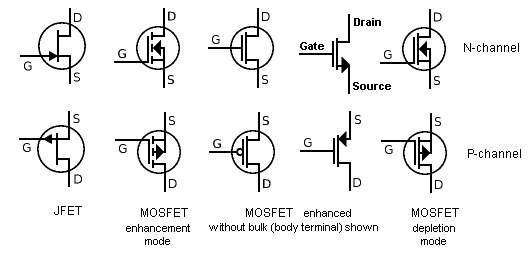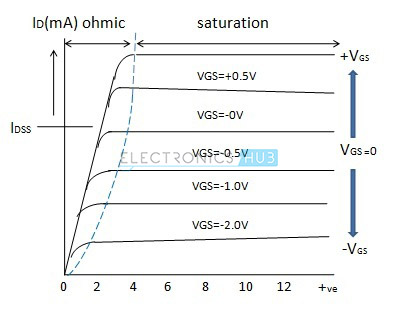FET, Field Effect Transistor, Tutorial Includes:
FET basicsFET specsJFETMOSFETDual gate MOSFETPower MOSFETMESFET / GaAs FETHEMT & PHEMTFinFET technology
The dual gate MOSFET is a useful form of MOSFET which can provide some distinct advantages, especially in RF applications.
The dual gate MOSFET can be considered in the same light as the tetrode vacuum tube or thermionic valve. The introduction of the second control electrode considerably reduced the level of feedback capacitance between the input and output circuits of the device. In this way it is possible to make far more stable amplifiers.
The FET is operated in both depletion and enhancement modes of operation. The following figure shows how a practical MOSFET looks like. Construction of a MOSFET The construction of a MOSFET is a bit similar to the FET. In an n-channel 'depletion-mode' device, a negative gate-to-source voltage causes a depletion region to expand in width and encroach on the channel from the sides, narrowing the channel. If the active region expands to completely close the channel, the resistance of the channel from source to drain becomes large, and the FET is effectively. Smart Filtering. As you select one or more parametric filters below, Smart Filtering will instantly disable any unselected values that would cause no results to be found. Applied Filters: Semiconductors Discrete Semiconductors Transistors MOSFET. Transistor Polarity = N-Channel Channel Mode = Depletion.

Also the additional gate enables the dual gate MOSFET to be used in RF mixer or RF multiplier circuits.
Dual gate MOSFET circuit symbol
The circuit symbol from he dual gate MOSFET expands the basic single gate MOSFET and adds a second gate into the input.
Enhancement and depletion mode as well as N channel and P channel devices can be described, although P channel devices tend not to be used much for RF applications because hole mobility is much less than electron mobility.
The basic dual gate MOSFET circuit symbols are shown below:
The dual gate MOSFET can be used in a number of applications including RF mixers /multipliers, RF amplifiers, amplifiers with gain control and the like.
Dual gate MOSFET structure
The dual gate MOSFET has what may be referred to as a tetrode construction where the two grids control the current through the channel.
The different gates control different sections of the channel which are in series with each other.
Dual gate MOSFET applications
Dual gate MOSFETs are used in many applications. Their attributes and characteristics mean that they can provide some distinct advantages for some forms of circuit.

Depletion Mode Mosfet Applications
- RF amplifier: Dual gate MOSFETs are able to operate with improved performance as amplifiers over single gated FETs. The dual gate MOSFET enables a cascode two stage amplifier to be constructed using a single device.
The cascade amplifier helps overcome the Miller effect where capacitance is present between the input and output stages. Although the Miller effect can relate to any impedance between the input and output, normally the most critical is capacitance. This capacitance can lead to an increase in the level of input capacitance experienced and in high frequency (e.g. VHF & UHF) amplifiers it can also lead to instability.
The effect is overcome by using a cascade amplifier using a single dual gate FET. In this configuration, biasing the drain-side gate at constant potential reduces the gain loss caused by Miller effect. The effects of capacitive coupling between the input and output are virtually eliminated. In this circuit the lower or input FET section is in a self-biased, common-source configuration. The upper or output FET section is configured in a in a voltage-divider biased, common-gate configuration.
Effectively a cascade amplifier is a two-stage amplifier formed from a trans-conductance amplifier which is followed by a current buffer. This provides a high level of input-output isolation, high input impedance, high output impedance, higher gain or higher bandwidth when compared to a single stage amplifier.
A cascode amplifier using a dual gate MOSFET is commonly used in radio receiver front ends. In these applications, the dual-gate MOSFET is operated as a common source amplifier with the primary gate, i.e. gate 1, G1 connected to the input and the second gate, G2 grounded to RF via the capacitor. - RF mixer / multiplier: The dual gate MOSFET is able to provide a basis for an RF mixer. The dual gate MOSFET operation enables both the local oscillator and RF signal inputs to be accommodated. As shown in the circuit below, the RF signal is normally applied to gate 1 and the local oscillator to gate 2.
The operation of this dual gate MOSFET circuit is relatively easy to understand. The RF signal appears at gate 1 and controls the channel current in the normal way. However the much higher level local oscillator signal is applied to gate 2 and superimposes its effect on the channel current. - Level / gain control: The output from the dual gate MOSFET is proportional to the input at both of the gates. With a constant level at gate 1, for example, varying the voltage on gate 2 will alter the output level. Accordingly the dual gate MOSFET can be used to provide linear gain control.
Depletion Mode Fet Applications

The dual gate MOSFET is a useful component to be able to incorporate into circuit designs when appropriate. Although single gate FETs are by far the most widely used, the characteristics of the dual gate MOSFET can provide some very useful improvements in performance in some applications.

Depletion Mode Jfet Ltspice
More Electronic Components:
ResistorsCapacitorsInductorsQuartz crystalsDiodesTransistorPhototransistorFETMemory typesThyristorConnectorsRF connectorsValves / TubesBatteriesSwitchesRelays
Return to Components menu . . .
